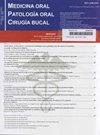Comparison of a daily and alternate-day photobiomodulation protocol in the prevention of oral mucositis in patients undergoing radiochemotherapy for oral cancer: a triple-blind, controlled clinical trial.
IF 2.1
3区 医学
引用次数: 0
Abstract
BACKGROUND Preventive Photobiomodulation Therapy (PBMT) significantly reduces oral mucositis (OM) severity in patients undergoing Radiochemotherapy (RCT) for the treatment of oral cancer, but daily applications generate cost, overload the dental team, and reduce the number of patients assisted.To evaluate the effectiveness of two PBMT protocols in preventing OM in patients undergoing RCT for oral cancer. MATERIAL AND METHODS 16 patients diagnosed with oral cancer undergoing RCT were included, equally divided into two groups: a group treated daily with PBMT, and another group also submitted to daily treatment, however, performing the application of PBMT every three days, interspersed with a simulation of PBMT (placebo). A red laser was used (~660 nm), 0.1W power, 1J of energy applied per point, 9 points per area (labial mucosa, buccal mucosa, lateral borders of the tongue, body of the tongue, and floor of the mouth) from the beginning of RCT until the end of the oncological treatment. Daily assessments were performed regarding OM scores, the World Health Organization (WHO) pain scale, and the visual analog scale (VAS). Weight, salivary flow (SGAPP), OHIP-14, and DMFT were evaluated on the initial and final days of RT. OM incidence and clinical data were compared by Pearson's chi-square test or Fisher's exact test. Pain and other scale scores were compared using the Mann-Whitney and Friedman/Dunn tests (SPSS v20.0 p<0.05). RESULTS In the group with PBMT on alternate days, there was an increase in the frequency of grade 2 and grade 3 oral mucositis and an increased risk of grade 2 oral mucositis, in addition to higher mean pain scores and greater reduction in salivary flow. CONCLUSIONS The daily PBMT protocol proved more effective in controlling the frequency and severity of OM, pain, and salivary flow.比较每日和隔日光生物调节方案对口腔癌放化疗患者口腔粘膜炎的预防作用:一项三盲对照临床试验。
背景预防性光生物调节疗法(PBMT)可明显减轻接受放射化学治疗(RCT)的口腔癌患者的口腔黏膜炎(OM)严重程度,但每日应用会产生费用,加重牙科团队的负担,并减少受助患者的数量。材料和方法纳入 16 名接受 RCT 治疗的口腔癌患者,将其平均分为两组:一组每天接受 PBMT 治疗,另一组也是每天接受治疗,但每三天应用一次 PBMT,中间穿插模拟 PBMT(安慰剂)。从 RCT 开始到肿瘤治疗结束,使用红色激光(约 660 纳米),功率 0.1W,每点能量 1J,每个区域 9 点(唇粘膜、颊粘膜、舌侧缘、舌体和口底)。每天对 OM 评分、世界卫生组织(WHO)疼痛量表和视觉模拟量表(VAS)进行评估。在 RT 治疗的最初和最后几天对体重、唾液流量(SGAPP)、OHIP-14 和 DMFT 进行评估。OM发生率和临床数据通过皮尔逊卡方检验或费雪精确检验进行比较。结果在隔天进行 PBMT 的组中,2 级和 3 级口腔黏膜炎的发生频率增加,2 级口腔黏膜炎的风险增加,此外平均疼痛评分更高,唾液流量减少更多。
本文章由计算机程序翻译,如有差异,请以英文原文为准。
求助全文
约1分钟内获得全文
求助全文
来源期刊

Medicina oral, patologia oral y cirugia bucal
Medicine-Surgery
CiteScore
4.50
自引率
0.00%
发文量
52
期刊介绍:
1. Oral Medicine and Pathology:
Clinicopathological as well as medical or surgical management aspects of
diseases affecting oral mucosa, salivary glands, maxillary bones, as well as
orofacial neurological disorders, and systemic conditions with an impact on
the oral cavity.
2. Oral Surgery:
Surgical management aspects of diseases affecting oral mucosa, salivary glands,
maxillary bones, teeth, implants, oral surgical procedures. Surgical management
of diseases affecting head and neck areas.
3. Medically compromised patients in Dentistry:
Articles discussing medical problems in Odontology will also be included, with
a special focus on the clinico-odontological management of medically compromised patients, and considerations regarding high-risk or disabled patients.
4. Implantology
5. Periodontology
 求助内容:
求助内容: 应助结果提醒方式:
应助结果提醒方式:


